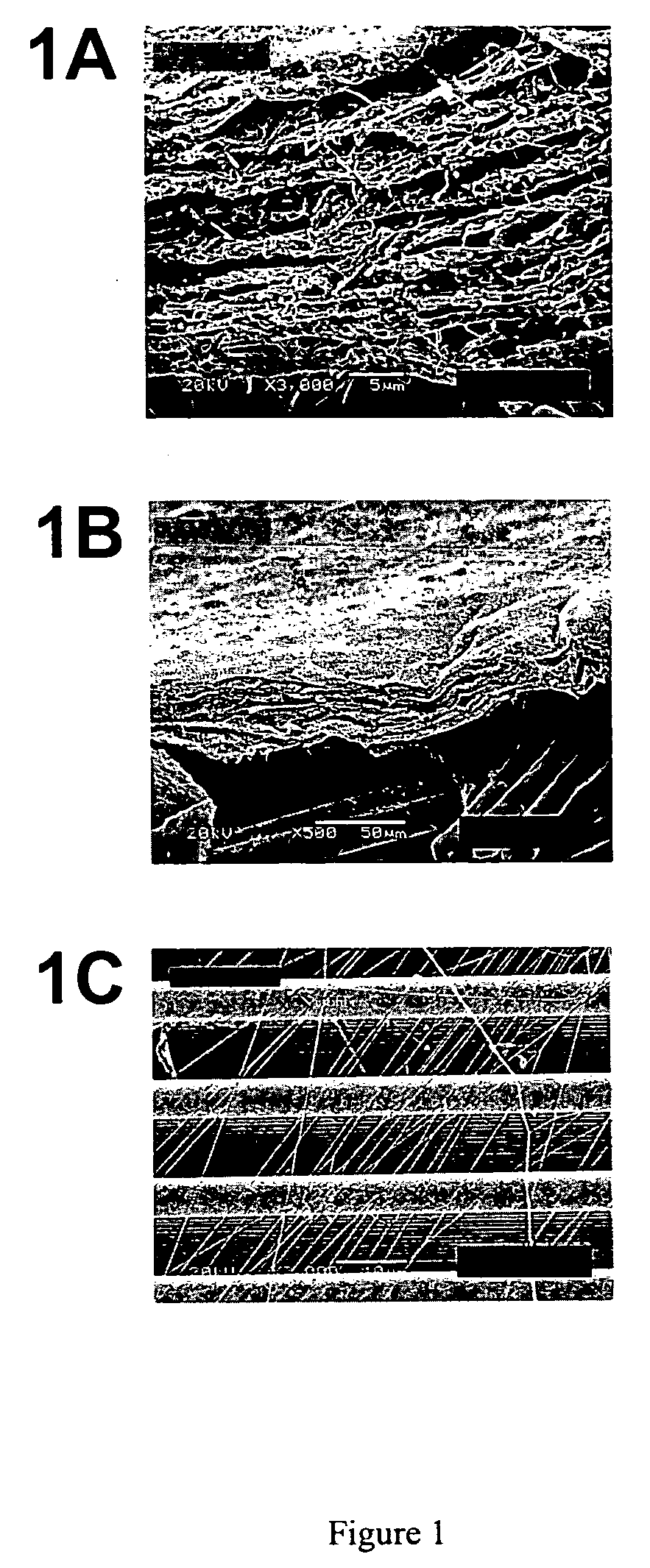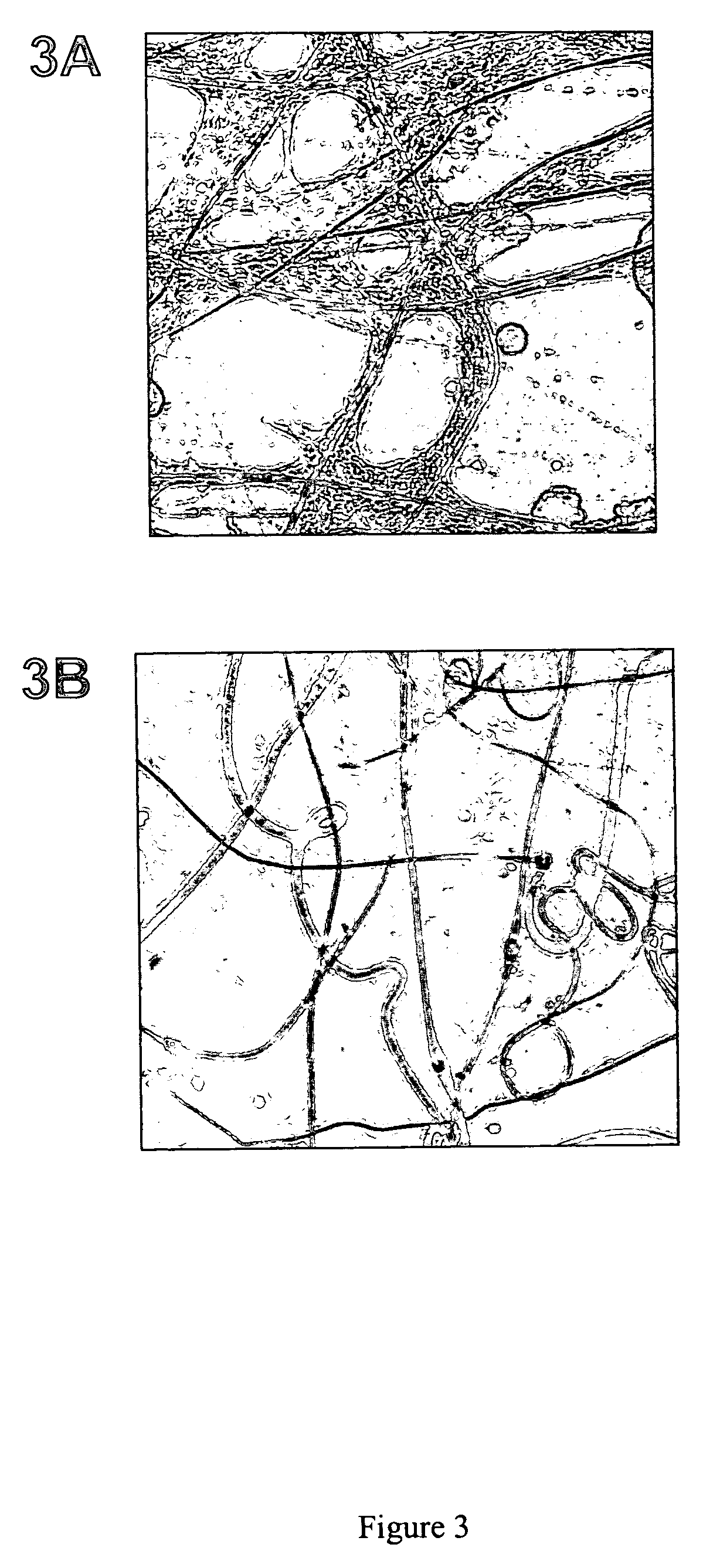Nanofibrillar structure and applications including cell and tissue culture
a technology of nanofibers and nanofibers, applied in nanostructure manufacturing, monocomponent polyester artificial filaments, biomass after-treatment, etc., can solve the problems of multiple layers of fine fibers, insufficient environment for cell growth, and limited efforts
- Summary
- Abstract
- Description
- Claims
- Application Information
AI Technical Summary
Benefits of technology
Problems solved by technology
Method used
Image
Examples
example 1
Electrospinning a Polymer Solution Comprising a Lipid Produces an Enhanced Population of Thin Fibers
[0137] To visualize the changes in fiber diameter associated with the addition of a lipid to a polymer solution using an optical microscope, fibers were electrospun to obtain microfibers. Microfibers were electrospun from a solution comprising 15% poly(ε-caprolactone) (w / w) in chloroform supplemented with (Dow Tone Polymers, Midland, Mich.) 0, 0.25, 0.5, 1.0 and 1-% respectively of cholesterol (w / w) (Sigma, St. Louis, Mo.). The fibers were electrospun using a capillary needle system. An Eppendorf micropipiette tip (yellow) was fitted to a 5 cc syringe. The polymer solution was poured into the syringe and a positive electrode connected to a Nanosecond Optical Pulse Radiator Model NR-1 (Optitron, Inc., Torrance, Calif.) was inserted into the solution. The electrospinning voltage was 18,000 volts. The fibers were electrospun onto a grounded metal plate target spinning in a plane perpend...
example 2
Nanofibers Comprising a Lipid Induce Tight Attachment of Cells to the Nanofilber
[0139] Nanofibers comprising a lipid provide a surface that promotes recruitment of cells and tight association between the cells and nanofibers. Normal kidney rat (NRK) fibroblasts were cultured on nanofibers electrospun from a solution comprising 10% poly(ε-caprolactone) (w / w) in chloroform supplemented with 0.25% sphingomyelin in Dulbecco Modified Eagle's Medium (DME) at 37° C. in 5% CO2 and visualized on a light microscope (Insight Bilateral Scanning Confocal Fluorescence Microscope (Meridian Instruments, Okemos, Mich.)) with a 20× objective. Images were captured with a CCD camera.
[0140] As shown in FIGS. 3A and B, nanofibers comprising 0.25% sphingomyelin induce a rapid recruitment of cells and their attachment to the nanofibers. FIG. 3A shows NRK fibroblasts after two days of culture on a tissue culture plate coated with nanofibers comprising 0.25% sphingomyelin. The fibroblasts are tightly attac...
example 3
Cells Grown on Nanofiber Network have Actin Networks Similar to Cells within Tissue
[0141] The actin network of a cell has been utilized as a marker to determine which cell culture methods most closely approximate the environments within tissues (Cukierman et al., 2001, Science, 23:1708-1712; Walpita and Hay, 2002, Nature Rev. Mol. Cell. Biol., 3:137-141). When grown in two-dimensional tissue culture, fibroblasts assume a highly spread and adhering morphology in which the actin network located within the cytoplasm is organized into arrays of thick stress fibers. In contrast, fibroblasts observed in tissues are spindle-like in shape with actin organized in a cortical ring (Walpita and Hay, 2002, Nature Rev. Mol. Cell. Biol., 3:137-141).
[0142] We compared the actin network of normal rat kidney (NRK) fibroblasts grown on two-dimensional and three-dimensional surfaces. Fibroblasts were grown on polyamide nanofiber network, glass, and glass coated with polylysine. The polyamide nanofibe...
PUM
| Property | Measurement | Unit |
|---|---|---|
| Fraction | aaaaa | aaaaa |
| Fraction | aaaaa | aaaaa |
| Fraction | aaaaa | aaaaa |
Abstract
Description
Claims
Application Information
 Login to View More
Login to View More - R&D
- Intellectual Property
- Life Sciences
- Materials
- Tech Scout
- Unparalleled Data Quality
- Higher Quality Content
- 60% Fewer Hallucinations
Browse by: Latest US Patents, China's latest patents, Technical Efficacy Thesaurus, Application Domain, Technology Topic, Popular Technical Reports.
© 2025 PatSnap. All rights reserved.Legal|Privacy policy|Modern Slavery Act Transparency Statement|Sitemap|About US| Contact US: help@patsnap.com



